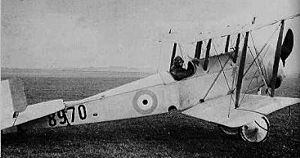Bristol Scout
| Bristol Scout | |
|---|---|
 |
|
| RNAS Bristol Scout D of third production batch | |
| Role | single-seat scout/fighter |
| Manufacturer | British and Colonial Aeroplane Company |
| Designer | Frank Barnwell |
| First flight | 23 February 1914 |
| Primary users |
Royal Flying Corps Royal Naval Air Service Australian Flying Corps |
| Produced | 1914–1916 |
| Number built | 374 |
The Bristol Scout was a single-seat rotary-engined biplane originally designed as a racing aircraft. Like similar fast, light aircraft of the period it was used by the RNAS and the RFC as a "scout", or fast reconnaissance type. It was one of the first single-seaters to be used as a fighter aircraft, although it was not possible to fit it with an effective forward-firing armament until the first British synchronisation gears became available, by which time the Scout was obsolescent. Single-seat fighters continued to be called "scouts" in British usage into the early 1920s.
The Bristol Scout was designed in the second half of 1913 by Frank Barnwell and Harry Busteed, Bristol's chief test pilot, who thought of building a small high-performance biplane while testing the Bristol X.3 seaplane, a project which had been designed by a separate secret design department headed by Barnwell. The design was initially given the works number SN.183, inherited from a cancelled design for the Italian government undertaken by Henri Coanda, the half-finished fuselage of which remained in the workshops and the drawings for the aircraft bore this number.
The design was an equal-span single-bay biplane with staggered parallel-chord wings with raked wingtips and ailerons fitted to the upper and lower wings, which were rigged with about half a degree of dihedral, making them look almost straight when viewed from the front. The wing section was one designed by Coanda which had been used for the wings of the Bristol Coanda Biplanes. The rectangular-section fuselage was an orthodox wire-braced wooden structure constructed from ash and spruce, with the forward section covered with aluminium sheeting and the rear section fabric covered. It was powered by an 80 hp (60 kW) Gnome Lambda rotary engine enclosed in a cowling that had no open frontal area, although the bottom was cut away to allow cooling air to get to the engine. It had a rectangular balanced rudder with no fixed fin and split elevators attached to a non-lifting horizontal stabiliser. The fixed horizontal tail surfaces were outlined in steel tube with wooden ribs and the elevators constructed entirely of steel tube.
...
Wikipedia
